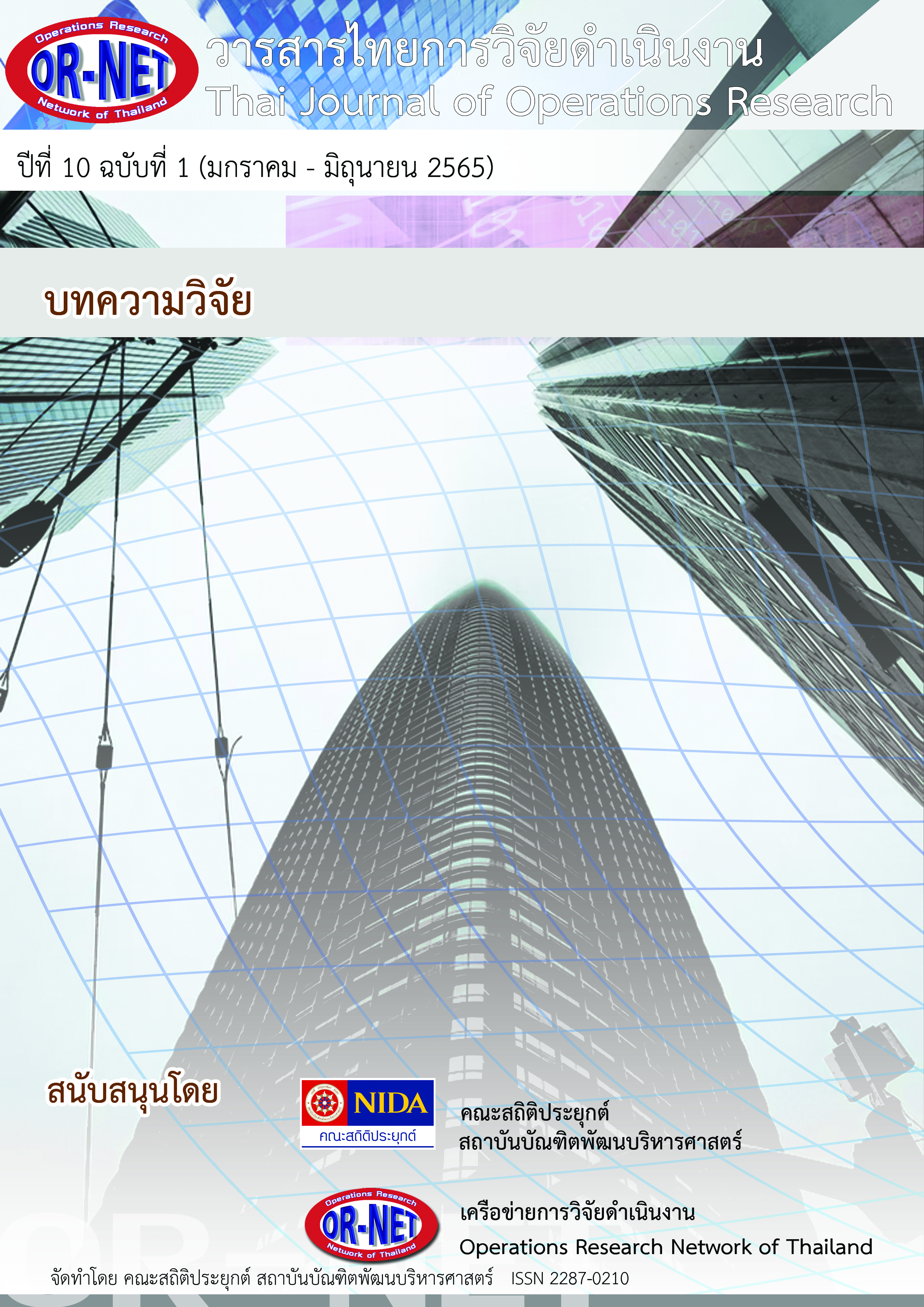Street Fashion Company’s Optimal Order Quantity Using Newsvendor Model and Simulation Model
Keywords:
Street fashion, Demand Forecasting, The suitable order quantity for purchasing, Newsvendor model, Expected profit maximizationAbstract
The objective of this research is to study the demand forecasting to increase the forecast accuracy of each product category. The forecasting step is carried out using R Studio program to minimize the MAPE among several forecasting models such as the state space model for exponential smoothing (ETS), the autoregressive integrated moving average (ARIMA) model and the neural network autoregression (NNAR) model. Then, we study and analyze the data to find the suitable order quantity, using the basic newsvendor model. After that, we compare the order quantity, revenue, and profit between the company’s current company and the new policy with the basic newsvendor model. After we deploy the new policy, we find that the order quantity decreases 3,541 pieces or 12.31%%, compared to those of the current company policy, and the profit increases 575,682.49 Baht or 2.07% %, compared to those of the current company policy. Next, we study and improve the modified newsvendor model to incorporate the promotional sales events after the selling season ends. Taking the company’s practice, which has the seasonal regular sales and sales event, into account to run the simulation to find of the suitable order quantity for purchasing, revenue, and profit under three different scenarios, namely the current company policy, the new policy from the basic newsvendor model, and the optimization policy from the modified newsvendor model. As the conclusion of this study, using the optimization policy results in the total order quantity 21,141 pieces (decreased 7,613 pieces or 26.48% compared to those of the company policy) and the max profit 34,522,135.58 Baht (increased 15,818,564.43 Baht or 84.58% compared to those of the company policy). Additionally, when the order quantity decreases, the inventory after-seasonal regular sales will decrease as well, leading to the decreased in the inventory day from 10.91 months to 4.84 months and to the inventory cost saving.
References
Hyndman, R.J. and Athanasopoulos, G. 2021. Forecasting: principles and practice, 3rd edition, OTexts: Melbourne, Australia.
พัชราภรณ์ เนียมมณี. 2556. ตัวแบบการจัดการทรัพยากร. กรุงเทพฯ: โครงการส่งเสริมและพัฒนาเอกสารวิชาการ สถาบันบัณฑิตพัฒนบริหารศาสตร์.
อนุสรณ์ บุญสง่า. 2559. การพยากรณ์ความต้องการแว่นตา กรณีศึกษา: ร้านรักแว่น. การค้นคว้าอิสระปริญญามหาบัณฑิต มหาวิทยาลัยศรีปทุม.
กานต์ ยงศิริวิทย์ และภาคภูมิ ชัยศิริประเสริฐ. 2560. การวิเคราะห์ข้อมูลปริมาณมหาศาลเพื่อพยากรณ์จำนวนผู้เข้ารับบริการด้านสุขภาพในประเทศไทยโดยใช้โปรแกรมภาษา R. การประชุมวิชาการระดับชาติ วิทยาศาสตร์และเทคโนโลยีระหว่างสถาบัน ครั้งที่ 5. 2560 (พฤษภาคม): 1310-1316.
อวยพร พู่วณิชย์ ศิวิกา ดุษฎีโหนด และกาญจ์นภา อมรัชกุล. 2558. ตัวแบบ Newsvendor ที่มีข้อจำกัดเรื่องงบประมาณ: กรณีศึกษาแบรนด์เสื้อผ้าแฟชั่น. การประชุมวิชาการด้านการวิจัยดำเนินงานแห่งชาติ ประจำปี 2558. 2558: 21-25.
ณัฐพร เกียรติเลิศเสรี และกาญจ์นภา อมรัชกุล. 2563. การกำหนดปริมาณการผลิตข้าวเปลือกที่เหมาะสมเพื่อตอบสนองความต้องการของผู้บริโภคในปัจจุบันและอนาคตด้วยตัวแบบ Newsvendor. การประชุมวิชาการด้านการวิจัยดำเนินงานแห่งชาติ ประจำปี 2563. 2563(กุมภาพันธ์): 41-54.
กุลวุฒิ โตรอด ชานนท์ พรมสกล และกนกพร ศรีปฐมสวัสดิ์. 2563. ตัวแบบสโตแคสติกสำหรับการสั่งซื้อรถโฟร์คลิฟท์เพื่อจำหน่ายภายใต้งบประมาณที่จำกัด. วารสารวิชาการเทคโนโลยีอุตสาหกรรม. 2563(มีนาคม): 47-61.
อดิศัย วรรธนะภูติ และสรวิชญ์ เยาวสุวรรณไชย. 2558. แบบจำลองคณิตศาสตร์สำหรับกระบวนการสั่งซื้อธุรกิจนำเข้า. การประชุมวิชาการเสนอผลงานวิจัยระดับบัณฑิตศึกษาแห่งชาติ ครั้งที่ 34. 2558(มีนาคม): 1466-1477.
Downloads
Published
How to Cite
Issue
Section
License

This work is licensed under a Creative Commons Attribution-NonCommercial-NoDerivatives 4.0 International License.




